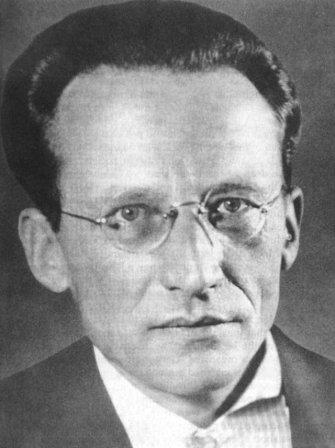

The idea of a particle existing in a superposition of possible states, while a fact of quantum mechanics, is a concept that does not scale to large systems (like cats), which are not indeterminably probabilistic in nature. The thought experiment serves to illustrate the strangeness of quantum mechanics and the mathematics necessary to describe quantum states.

Schrödinger's cat is the answer to Guess the Character (2).Schrödinger proposed his "cat" after debates with Albert Einstein over the Copenhagen interpretation, which Schrödinger defended, stating in essence that if a scenario existed where a cat could be so isolated from external interference (decoherence), the state of the cat can only be known as a superposition (combination) of possible rest states (eigenstates), because finding out (measuring the state) cannot be done without the observer interfering with the experiment - the measurement system (the observer) is entangled with the experiment. The philosophical question posed by the paradox is debated to this day. Schrdinger formulated this thought experiment in response to the Copenhagen interpretation of quantum mechanics, which states that a particle described by quantum mechanics exists in all possible states at the same time, until it is observed and is forced to choose one state. Other interpretations of quantum mechanics, such as the many-worlds interpretation, where reality splits into different branches for all the possible states, have been proposed. Schrödinger considered this impossible and concluded that the Copenhagen interpretation must be flawed. If the probability of radioactive decay over a specific time is, e.g., 50 %, the cat's wavefunction after that time would describe it as equal parts alive and dead. In 1935, Erwin Schrdinger put forward his famous gedanken experiment in which a microscopic degree of freedom - the emission state of a radioactive atom. Until one looks in the box, i.e., measures the state of the system, one cannot know if the cat is alive or dead. If no atom decays, no radiation is detected, and the cat lives. If radiation is detected, a flask filled with poisonous hydrogen cyanide in the chamber is smashed, and the cat dies. A Geiger counter measures whether an atom of the radioactive substance decays and emits radiation.

For this, the prominent Austrian physicist based himself on the hypothesis of Broglie, who. This proposal is known as the quantum-mechanical model of the atom, and describes the wave-like behavior of the electron. The Schrodinger atomic model was developed by Erwin Schrdinger in 1926. The experiment is set up like this (pictured right): A cat is locked in a chamber with a radioactive substance. Schrdinger’s atomic model: characteristics, postulates. Schrödinger's thought experiment relates the properties of such a small, quantum-mechanical system (a radioactive substance), to an everyday, large object (a cat). The many possible states are reduced to a single value when a measurement is performed the wavefunction is said to "collapse". These states have different probabilities, described by the object's wavefunction. A quantum object can, for example, be in two places at once or have two different speeds at the same time. Instead, an object can exist in a superposition of several states, i.e., it has different properties at the same time. It states that physical systems governed by quantum mechanics generally do not have definite properties before they are measured. The Copenhagen interpretation was devised between 19 by Niels Bohr and Werner Heisenberg. He used it to illustrate the possible paradox that arises when the Copenhagen interpretation of quantum mechanics is applied to everyday objects. Schrödinger's cat is the protagonist of a famous thought experiment by Austrian physicist Erwin Schrödinger. This constellation depicts the feline-equipped box at the center of a famous thought experiment devised by Austrian physicist Erwin Schrdinger in 1935. Quantum Mechanics Used to Study Possible Futures In the thought experiment, a hypothetical cat may be considered simultaneously both alive and dead as a result of its fate being linked to a random subatomic event that may or may not occur. Schrdinger developed a number of fundamental results in the field of quantum theory, which formed the basis of wave mechanics: he formulated the wave equation and revealed the identity of his development of the formalism and matrix mechanics. Erwin Schrdinger (1887-1961) On August 12, 1887, Austrian physicist and Nobel Laureate Erwin Schrdinger was born. Schrödinger's Cat Simultaneously in Two BoxesĪngewandte Chemie 39/2013: A Quantum of Nobility 'In quantum mechanics, Schrödingers cat is a thought experiment that illustrates a paradox of quantum superposition. Erwin Schrdinger and his Famous Thought Experiment.


 0 kommentar(er)
0 kommentar(er)
